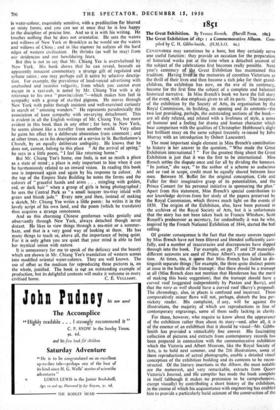The Chinese Eye
The Silent Traveller in New York. By Chiang Yee. (Methuen. 21s.)
HAVING read this delightful book and aemired its equally delightful pictures, I find Myself thinking how pleasant it would be to know Mr. Chiang Yee and how dreadful it would be to live in New York. For Mr. Chiang Yee believes in basic humanity ; he thinks the particulars wherein we all agree are more extensive, more essentially benign, than those in which we differ. "It is only grown-ups," he says, "who complicate matters by unnecessary discrimination."
The charm of Mr. Chiang Yee is to be found in his intently placid observation of colour, pattern, surface and effect. He has a liking for the cool sophisticated glow of emerald green, and it is the same cool glow that you find in all his descriptions, whether visual or verbal. Into the darker, more passionate and alarming scenes of life Mr. Chiang Yee has no wish to enter. His medium
Is water-colour, exquisitely sensitive, with-a predilection for blurred or misty forms, and you can see at once that he is less happy in the discipline of precise line. And so it is with his writing. He touches nothing that he does not orientalise. He sees the waters and willows of New York or Brooklyn as he would see the waters and willows of China ; and in like-manner he softens all the hard edges of western civilisation. He Shrinks (as well he may) from our stridencies and our bewildering fears.
But this is not to say that Mr. Chiang Yee is overwhelmed by New York. His book shows that he can reveal, beneath an apparently innocent commentary. a Orange gift of regulated and urbane satire ; one may perhaps call it satire by selective descrip- tion. For example, the prevalence of loud-voiced advertising with unabashed and raucous vulgarity, from which you cannot even escape in a taxi-cab, is noted by Mr. Chiang Yee with a sly reference to his own " provincialism "—which makes him feel in sympathy with a group of startled pigeons. He moves through New York with polite though insistent and well-exercised curiosity in search of "amusing wonders." He represents paradoxically the association of keen sympathy with unvarying detachment. This is evident in all the English writings of Mr. Chiang Yee, but more evident in this book than in any other ; for here, in New York, he seems almost like a traveller from another world. Very often he gains his effect by a deliberate abstention from comment ; and at other times, as in his description of a service in St. Bartholomew's Church, by an equally deliberate ambiguity. He knows that he does not, cannot, belong to this place "At the arrival of spring," he says in a little poem, "I feel like returning home."
But Mr. Chiang Yee's home, one feels, is not so much a place as a state of mind ; a place is only important to him when it can be harmoniously related to an inward vision. In reading this book one is impressed again and again by his response to colour. At the top of the Empire State Building he notes the forms and the colours of "graceful hands and arms . . . mingling with golden, red, or dark hair" when a group of girls is being photographed ; he sees the Central Park as "a small lacquer tea-tray inlaid with green and bluish jade." Every noticand then, instead of making a sketch, Mr. Chiang Yee writes a little poem: he writes it in the lovely script of his own land, and the poem (which he translates) thus acquires a strange remoteness. And so this charming Chinese gentleman walks genially and observantly through New York, always detached though never distant. He likes to view things through a sea-mist or a summer- haze, and that is a very good way of looking at them. He has many things to teach us, above all, the importance of being quiet. For it is only a'hen you are quiet that your mind is able to feel her mystical union with nature. It is unnecessary for me to speak of the delicacy and the beauty which are shown in Mr. Chiang Yee's translation of western scenes into modified oriental water-colours. They are well known. The use of offset as the medium for reproducing these pictures is, on the whole, justified. The book is not an outstanding example of production, but its delightful contents will make it welcome in every







































 Previous page
Previous page